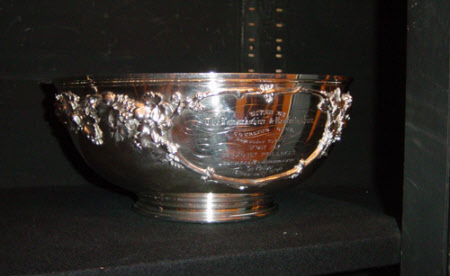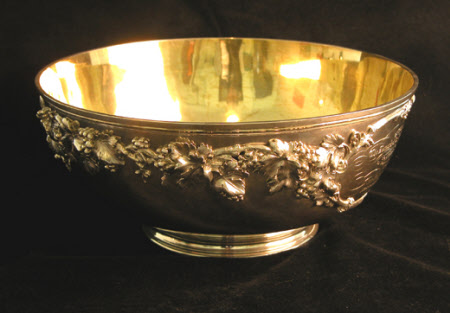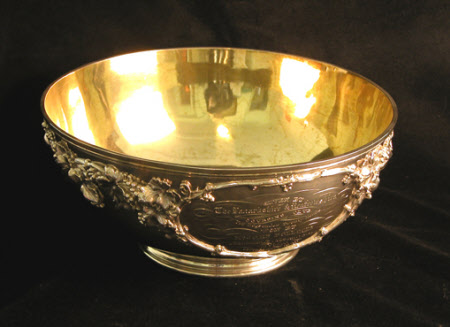Punchbowl
Edward Barnard and Sons
Category
Silver
Date
1829 - 1830
Materials
Silver, sterling
Measurements
12 x 27 cm; 1509 g (weight)
Place of origin
London
Order this imageCollection
Anglesey Abbey, Cambridgeshire
NT 516489
Summary
A punch bowl, silver, sterling, marked for Edward Barnard & Sons, London, 1829/30. The raised hemi-spherical bowl is soldered to a circular moulded cast collet foot. Beneath the applied moulded upper rim is an applied and chased border of vines and grapes with branches encircling two oval cartouches. One is engraved with a horse and rider in hilly countryside with, in the foreground, a pair of greyhounds chasing a hare. The opposite cartouche is inscribed: ‘GIVEN BY/ The Lanarkshire & Renfrewshire/ COURSING CLUB/ FOR DOGS UNDER TWENTY MONTHS/ WON BY/ Mr JOHN POLLOCK’S/ BRINDLED B. MARCHIONESS/ At Polloc/ 15th FEBRUARY 1830’. The interior is gilt. Heraldry: None Scratch weight: None
Full description
NOTE ON COURSING The ancient sport of hare coursing was formalised during the reign of Elizabeth I when the first set of rules was published, reputedly by Thomas Howard, 4th Duke of Norfolk. Laws of the Leash dictated that no more than two hounds should be permitted to chase a hare at any one time. The aim was not to see which sighthound caught the hare first, but to win points for the hound’s speed and ability to turn or direct the hare. Initially it was a gentleman’s sport with large sums of money being paid for the hounds and exchanged in bets. The first coursing club was founded at Swaffham in Norfolk in 1776, with a further 150 clubs in Britain by the 19th century. With the decline in popularity of blood sports, coursing developed into greyhound racing; and in 2004 the Hunting Act made the coursing of hares illegal. Jane Ewart, 2025
Provenance
John Pollock (Urban) Huttleston Rogers Broughton, 1st Baron Fairhaven (1896-1966) bequeathed by Lord Fairhaven to the National Trust along with the house and the rest of the contents National Trust
Credit line
Anglesey Abbey, the Fairhaven Collection (National Trust)
Marks and inscriptions
On the underside of the base: Hallmarks: lion passant (sterling), ‘o’ (1829/30), monarch’s head (duty mark), leopard’s head (London), and ‘EE/B/JW’ (Edward senior, Edward junior, John and William Barnard, for Edward Barnard & Sons*) *Arthur Grimwade: London Goldsmiths 1697-1837, London, 1990, p 52, no 575; and John Culme: The Directory of Gold & Silversmiths Jewellers & Allied Traders 1838-1914, Woodbridge, 1987, vol 1, pp 29-30 On the inside of the collet foot : Old NT Inventory Number: ‘AA/S/98’
Makers and roles
Edward Barnard and Sons, goldsmith


